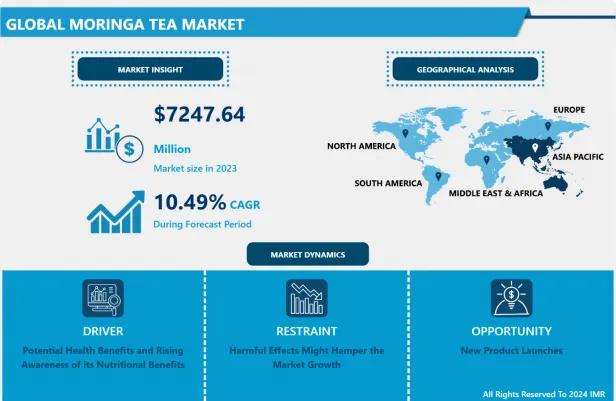Global Moringa Tea Market Overview
Moringa Tea Market Size Was Valued at USD 7247.64 Million in 2023 and is Projected to Reach USD 17787.03 Million by 2032, Growing at a CAGR of 10.49% From 2024-2032.
- Moringa tea is primarily prepared from the leaves of a plant called Moringa Oleifera and is now gaining popularity as a superfood with double protein as in milk, more than seven times vitamin C as compared to oranges, three times potassium than in bananas, and four times the vitamin A content than in carrots. The superfood has had its usage for centuries due to its nutritive and medicinal properties along with the health benefits that it provides. Owing to the rapid surge in awareness about its numerous health benefits, 13 species of Moringa are cultivated in other tropical and sub-tropical regions such as Africa, Islands in the Pacific and the Caribbean, Asia, and South America. Moringa tea prepared by brewing moringa leaves has a rare combination of and quercetin & kaempferol plant hormones. This combination of flavonoids is useful in relieving inflammation and preventing the buildup of cholesterol in the body, which further adds to the market growth. According to CDC, about 38% of Americans have high cholesterol thus, creating lucrative opportunity for the growth of Moringa tea market during the forecasted period.

Market Dynamics And Factors For Moringa Tea Market
Drivers:
Potential Health Benefits and Rising Awareness of its Nutritional Benefits
- Along with increasing health-related disorders, the awareness regarding the potential nutritional benefits of moringa tea is also rising. According to the USDA, raw moringa tea leaves carry 25 essential vitamins & minerals. It is a significant source of vitamin C (ascorbic acid), vitamin A, and vitamin B6. The leaves of the moringa plant have large amounts of essential nutrients such as beta-carotene and amino acids. For example, 100 grams of moringa leaves contain around 9 grams of protein. It is also an excellent source of vitamins & minerals. For instance, in 21 grams of chopped fresh moringa leaves, there are 2 grams of Protein, 19% Vitamin B6 of RDA, 12% Vitamin C, 11% Iron, 11% Riboflavin (B2), 9% Vitamin A (from beta-carotene), and 8% of Magnesium. In addition to vitamin C and beta-carotene, the presence of antioxidants in moringa tea such as Quercetin which helps in lowering blood pressure, and Chlorogenic acid which helps in moderating the blood sugar levels thus, driving the market development over the analysis period.
- Consumption of moringa tea offers potential health benefits due to which the growth is surging rapidly. High levels of free radicals may cause oxidative stress, which is associated with chronic diseases like heart disease and type 2 diabetes. Several antioxidant plant compounds have been found in the leaves of Moringa oleifera. The surge in health-conscious consumers and tea drinkers has led to the popularity of moringa tea in the global market. Moringa tea's nutritional value, in addition to being caffeine-free, makes it different from other tea products on the market. Moringa tea has a potent immune system booster and it helps to fight off sickness, and infections, and even speed up the healing of wounds. Besides combating liver damage, heart disease, and diabetes, these compounds also fight chronic inflammation. The tea is also widely consumed as it helps alleviate symptoms of anxiety, depression, and fatigue by balancing the serotonin and dopamine levels, which are crucial in mood regulation and pain perception. All such factors henceforth are anticipated to drive the moringa tea market growth.
Restraints:
Harmful Effects Might Hamper the Market Growth
- Despite numerous potential benefits, moringa tea has some side effects that can be harmful to the human body. Moringa tea if taken in large quantities, might exhibit laxative properties, which can further lead to upset stomachs, nausea, and heartburn. These factors might impede the growth of the moringa tea market. Further, breastfeeding women are also kept away from the consumption of moringa tea as there is no such evidence that states that ingredients in moringa tea are safe for infants. Although moringa leaves are known to reduce the heart rate lowering blood pressure effectively, they also can become dangerous when taken in combination with other medicines that lower blood pressure, thus hampering the market growth. Moringa can potentially interact with some of the medications for diabetes and thyroid as well, and consumption of moringa tea before consulting a doctor under such medical condition may harm the health of consumers. Additionally, large consumption can lead to organ and genotoxic damage thereby, increasing chances of developing cancer. These factors are anticipated to hinder the moringa tea market development during the projected period.
Opportunity:
New Product Launches
- Moringa tea is itself a value-added product, and introducing new flavors or substances effective for human health can offer profitable opportunities for the market players. New products that exhibit enhanced capabilities are majorly developed by key market players. Leading companies are also strengthening their R&D in making new moringa tea products with improved taste and flavor. Further, to serve the growing demand for organic food and beverages, as well as healthy and nutrition-rich foods, manufacturers are engaged in launching tea with organically grown moringa leaves. Efforts by the manufacturers are projected to offer potential opportunities for the market expansion. Major companies are strategically focusing on launching innovative health-promoting moringa tea products to suffice the growing demand among consumers. Companies such as Organic India, Grenera Nutrients Pvt. Ltd., Asia Botanicals Sdn Bhd, and others are focused on the launch of new moringa tea products to expand the market and contribute to the overall growth. For instance, in August 2022, Davidson’s introduced yet sustainably introduced a new line of moringa teas to the market. The new blends include Moringa Chai, Moringa Chamomile Lavendar, Moringa Ginger Lemon, Moringa Hibiscus Watermelon, Moringa Mango Peach, Moringa Mint Sage, Moringa Pure Leaves, and Moringa Strawberry Rose. Moreover, in March 2020, Typhoo Tea Limited, a U.K.-based tea manufacturer in India, launched three new organic herbal teas - Purifying Super Greens, Digestive Power Seeds, and Immunity-boosting Three Tulsi. The purifying super greens consist of organic moringa and a blend of other ingredients to offer holistic purifying benefits. Such effective product launches are expected to contribute to the expansion of the moringa tea market over the forecast period.
Segmentation Analysis Of the Moringa Tea Market
- By Nature, organic segment is expected to have the highest share of the moringa tea market. Organic food products usually offer more potential health benefits than that conventional products, and along with the rising awareness, the organic nature of moringa tea is witnessing huge demand. Organic tea is also beneficial as it does not include any use of chemicals like fertilizers, or pesticides that can harm human health. It also benefits human health multiple times more than the regular ones due to its natural compounds. Health-conscious consumers, especially, gym-going people, people suffering from certain chronic diseases, or diabetes, and others prefer organic tea to boost their immunity, henceforth, contributing to the segment growth of the moringa tea market.
- By Form, the crushed leaves segment is anticipated to dominate the market during the projected timeframe. Loose-leaf or crushed leaves form of tea provides far superior tea quality as compared to tea bags and thus is the primary reason for the dominance of this segment. Even low-quality tea leaves that are in crushed form offer a better flavor and aroma, as well as more nutrients than any standard tea bag. Crushed leaves also provide the consumers with the choice to prepare and consume the tea according to their needs, whereas, in tea bags, the amount is fixed which is usually around 1-3 grams. However, due to the ease and convenience of consumption, the tea bag segment is expected to witness rapid growth.
- By Distribution Channels, the offline segment set to lead the growth of the moringa tea market. The ease and convenience of shopping provided by offline retailers such as the presence of varied product aisles, discounts and offers on bulk purchases, numerous options to choose products, and a one-stop shopping center under the same roof are the major factors responsible for the huge growth of this segment. The specialty stores are growing rapidly as they provide the customers with a wide range of other nutritional and health-care products, which consumers can purchase along with their dietary supplements. Further, the easy availability of tea from leading brands and the presence of specialists who assist consumers in buying such products contribute to the growth of the offline segment.
Regional Analysis Of Moringa Tea Market
- The Asia Pacific holds the largest market share for the moringa tea market and is projected to dominate the growth in the foreseeable years. The abundant availability of moringa trees in the Asia Pacific region along with the large-scale consumption of its products like pods and leaves in India, Japan, and other countries all together contributes to the regional growth of the moringa tea market. Proponents of Ayurveda and natural therapies are also fostering the wide cultivation of moringa trees in the Asia Pacific region. Large volume export of moringa tea to the Western countries with an intent to serve their large population is further fuelling the moringa tea market in the Asia Pacific region.
- India is the largest producer of Moringa with an annual production of 2.2 million tonnes of tender fruits from a total area of 43,600 ha leading to maximum productivity of around 51 tonnes per ha. Among the different states in India, Andhra Pradesh is the leading state in both production & area (15,665 ha), followed by Tamil Nadu (13042 ha) and Karnataka (10,280 ha). In other states, it occupies an area of 4,613 ha. The significant increase in the R&D sector for introducing innovative possible products paves profitable opportunities for the moringa tea market to flourish in the Asia Pacific region. Moreover, the government in this region, especially in India, is highlighting the advantages of moringa products by organizing awareness campaigns, and providing beneficial subsidies which are further estimated to boost the market. For instance, the National Bank for Agriculture and Rural Development offers subsidies to farmers all across the nation, while the government of Tamil Nadu state is also contributing by providing subsidies to farmers for the cultivation of this herb. All such factors thus lead to the moringa tea market in the Asia Pacific region.
- Europe is expected to witness the fastest growth in the moringa tea market over the upcoming years. The region is also studied to generate immense growth opportunities for Moringa Tea, with Germany contributing the maximum. The European moringa tea market is majorly driven by the huge export of moringa tea to other countries across the world. The European region is also perceiving rapid growth due to the increasing popularity of nutritional supplements among health-conscious consumers. Developed countries like Germany, the U.K., Netherlands, and Italy are among the major nutritional supplements market in the region along with much more awareness about the product. Growing demand for Moringa tea in the European region due to awareness such as promotes weight loss, helps in food digestion, prevents diseases, provides nourishment, and improves skin health drives the market growth. Further, the major inclination of consumers toward maintaining a balanced diet coupled with health and fitness trends is anticipated to offer fast growth opportunities.
Top Key Players Covered In Moringa Tea Market
- Aayuritz Phytonutrients Pvt. Ltd
- Ancient Greenfields Pvt Ltd.
- Asia Botanicals Sdn Bhd
- Bio moringa Oleifera Gmbh
- Earth Expo Company
- Green Earth Products Pvt. Ltd.
- Grenera
- Kuli Kuli
- Rootalive
- Philippine Moringa
- Rainforest Herbs
- Organic India
- Earth Expo Company
- Genius Nature Herbs, and other major players.
Key Industry Development In The Moringa Tea Market
- In May 2022, Organic India launched a new and exciting variety of tea like Tulsi Detox Kahwa and infusions such as Peppermint Refresh, Moringa hibiscus, and Simply Chamomile. Each of the newly launched products has a unique taste and significance built into it. The Peppermint combined with Tulsi will make the consumers feel refreshed and rejuvenated. Moringa is packed with several nutrients that are the goodness of several ayurvedic herbs essential for immunity building.
- In May 2020, Green Provisions introduced moringa iced tea that is significantly prepared from high-quality moringa leaves. It is a premium iced tea along with a convenient bottled pack. The great-tasting drink is available in 16oz bottles and is all-natural, organic, caffeine-free, and has no high fructose corn syrup. The iced tea is made with 100% brewed Moringa leaves which have won praise for its 46 antioxidants and 96 nutrients and can boost the immune system, safely.
|
Moringa Tea Market |
|||
|
Base Year: |
2023 |
Forecast Period: |
2024-2032 |
|
Historical Data: |
2017 to 2023 |
Market Size in 2023: |
USD 7247.64 Mn. |
|
Forecast Period 2024-32 CAGR: |
10.49% |
Market Size in 2032: |
USD 17787.03 Mn. |
|
Segments Covered: |
By Nature |
|
|
|
By Form |
|
||
|
By Distribution Channel |
|
||
|
By Region |
|
||
|
Key Market Drivers: |
|
||
|
Key Market Restraints: |
|
||
|
Key Opportunities: |
|
||
|
Companies Covered in the report: |
|
||
Chapter 1: Introduction
1.1 Research Objectives
1.2 Research Methodology
1.3 Research Process
1.4 Scope and Coverage
1.4.1 Market Definition
1.4.2 Key Questions Answered
1.5 Market Segmentation
Chapter 2:Executive Summary
Chapter 3:Growth Opportunities By Segment
3.1 By Nature
3.2 By Form
3.3 By Distribution Channels
Chapter 4: Market Landscape
4.1 Porter's Five Forces Analysis
4.1.1 Bargaining Power of Supplier
4.1.2 Threat of New Entrants
4.1.3 Threat of Substitutes
4.1.4 Competitive Rivalry
4.1.5 Bargaining Power Among Buyers
4.2 Industry Value Chain Analysis
4.3 Market Dynamics
4.3.1 Drivers
4.3.2 Restraints
4.3.3 Opportunities
4.5.4 Challenges
4.4 Pestle Analysis
4.5 Technological Roadmap
4.6 Regulatory Landscape
4.7 SWOT Analysis
4.8 Price Trend Analysis
4.9 Patent Analysis
4.10 Analysis of the Impact of Covid-19
4.10.1 Impact on the Overall Market
4.10.2 Impact on the Supply Chain
4.10.3 Impact on the Key Manufacturers
4.10.4 Impact on the Pricing
Chapter 5: Moringa Tea Market by Nature
5.1 Moringa Tea Market Overview Snapshot and Growth Engine
5.2 Moringa Tea Market Overview
5.3 Conventional
5.3.1 Introduction and Market Overview
5.3.2 Historic and Forecasted Market Size (2017-2032F)
5.3.3 Key Market Trends, Growth Factors and Opportunities
5.3.4 Conventional: Grographic Segmentation
5.4 Organic
5.4.1 Introduction and Market Overview
5.4.2 Historic and Forecasted Market Size (2017-2032F)
5.4.3 Key Market Trends, Growth Factors and Opportunities
5.4.4 Organic: Grographic Segmentation
Chapter 6: Moringa Tea Market by Form
6.1 Moringa Tea Market Overview Snapshot and Growth Engine
6.2 Moringa Tea Market Overview
6.3 Crushed Leaves
6.3.1 Introduction and Market Overview
6.3.2 Historic and Forecasted Market Size (2017-2032F)
6.3.3 Key Market Trends, Growth Factors and Opportunities
6.3.4 Crushed Leaves: Grographic Segmentation
6.4 Tea Infusion Bags
6.4.1 Introduction and Market Overview
6.4.2 Historic and Forecasted Market Size (2017-2032F)
6.4.3 Key Market Trends, Growth Factors and Opportunities
6.4.4 Tea Infusion Bags: Grographic Segmentation
Chapter 7: Moringa Tea Market by Distribution Channels
7.1 Moringa Tea Market Overview Snapshot and Growth Engine
7.2 Moringa Tea Market Overview
7.3 Online
7.3.1 Introduction and Market Overview
7.3.2 Historic and Forecasted Market Size (2017-2032F)
7.3.3 Key Market Trends, Growth Factors and Opportunities
7.3.4 Online: Grographic Segmentation
7.4 Offline
7.4.1 Introduction and Market Overview
7.4.2 Historic and Forecasted Market Size (2017-2032F)
7.4.3 Key Market Trends, Growth Factors and Opportunities
7.4.4 Offline: Grographic Segmentation
Chapter 8: Company Profiles and Competitive Analysis
8.1 Competitive Landscape
8.1.1 Competitive Positioning
8.1.2 Moringa Tea Sales and Market Share By Players
8.1.3 Industry BCG Matrix
8.1.4 Ansoff Matrix
8.1.5 Moringa Tea Industry Concentration Ratio (CR5 and HHI)
8.1.6 Top 5 Moringa Tea Players Market Share
8.1.7 Mergers and Acquisitions
8.1.8 Business Strategies By Top Players
8.2 AAYURITZ PHYTONUTRIENTS PVT. LTD
8.2.1 Company Overview
8.2.2 Key Executives
8.2.3 Company Snapshot
8.2.4 Operating Business Segments
8.2.5 Product Portfolio
8.2.6 Business Performance
8.2.7 Key Strategic Moves and Recent Developments
8.2.8 SWOT Analysis
8.3 ANCIENT GREENFIELDS PVT LTD.
8.4 ASIA BOTANICALS SDN BHD
8.5 BIO MORINGA OLEIFERA GMBH
8.6 EARTH EXPO COMPANY
8.7 GREEN EARTH PRODUCTS PVT. LTD.
8.8 GRENERA
8.9 KULI KULI
8.10 ROOTALIVE
8.11 PHILIPPINE MORINGA
8.12 RAINFOREST HERBS
8.13 ORGANIC INDIA
8.14 EARTH EXPO COMPANY
8.15 GENIUS NATURE HERBS
8.16 OTHER MAJOR PLAYERS
Chapter 9: Global Moringa Tea Market Analysis, Insights and Forecast, 2017-2032
9.1 Market Overview
9.2 Historic and Forecasted Market Size By Nature
9.2.1 Conventional
9.2.2 Organic
9.3 Historic and Forecasted Market Size By Form
9.3.1 Crushed Leaves
9.3.2 Tea Infusion Bags
9.4 Historic and Forecasted Market Size By Distribution Channels
9.4.1 Online
9.4.2 Offline
Chapter 10: North America Moringa Tea Market Analysis, Insights and Forecast, 2017-2032
10.1 Key Market Trends, Growth Factors and Opportunities
10.2 Impact of Covid-19
10.3 Key Players
10.4 Key Market Trends, Growth Factors and Opportunities
10.4 Historic and Forecasted Market Size By Nature
10.4.1 Conventional
10.4.2 Organic
10.5 Historic and Forecasted Market Size By Form
10.5.1 Crushed Leaves
10.5.2 Tea Infusion Bags
10.6 Historic and Forecasted Market Size By Distribution Channels
10.6.1 Online
10.6.2 Offline
10.7 Historic and Forecast Market Size by Country
10.7.1 U.S.
10.7.2 Canada
10.7.3 Mexico
Chapter 11: Europe Moringa Tea Market Analysis, Insights and Forecast, 2017-2032
11.1 Key Market Trends, Growth Factors and Opportunities
11.2 Impact of Covid-19
11.3 Key Players
11.4 Key Market Trends, Growth Factors and Opportunities
11.4 Historic and Forecasted Market Size By Nature
11.4.1 Conventional
11.4.2 Organic
11.5 Historic and Forecasted Market Size By Form
11.5.1 Crushed Leaves
11.5.2 Tea Infusion Bags
11.6 Historic and Forecasted Market Size By Distribution Channels
11.6.1 Online
11.6.2 Offline
11.7 Historic and Forecast Market Size by Country
11.7.1 Germany
11.7.2 U.K.
11.7.3 France
11.7.4 Italy
11.7.5 Russia
11.7.6 Spain
11.7.7 Rest of Europe
Chapter 12: Asia-Pacific Moringa Tea Market Analysis, Insights and Forecast, 2017-2032
12.1 Key Market Trends, Growth Factors and Opportunities
12.2 Impact of Covid-19
12.3 Key Players
12.4 Key Market Trends, Growth Factors and Opportunities
12.4 Historic and Forecasted Market Size By Nature
12.4.1 Conventional
12.4.2 Organic
12.5 Historic and Forecasted Market Size By Form
12.5.1 Crushed Leaves
12.5.2 Tea Infusion Bags
12.6 Historic and Forecasted Market Size By Distribution Channels
12.6.1 Online
12.6.2 Offline
12.7 Historic and Forecast Market Size by Country
12.7.1 China
12.7.2 India
12.7.3 Japan
12.7.4 Singapore
12.7.5 Australia
12.7.6 New Zealand
12.7.7 Rest of APAC
Chapter 13: Middle East & Africa Moringa Tea Market Analysis, Insights and Forecast, 2017-2032
13.1 Key Market Trends, Growth Factors and Opportunities
13.2 Impact of Covid-19
13.3 Key Players
13.4 Key Market Trends, Growth Factors and Opportunities
13.4 Historic and Forecasted Market Size By Nature
13.4.1 Conventional
13.4.2 Organic
13.5 Historic and Forecasted Market Size By Form
13.5.1 Crushed Leaves
13.5.2 Tea Infusion Bags
13.6 Historic and Forecasted Market Size By Distribution Channels
13.6.1 Online
13.6.2 Offline
13.7 Historic and Forecast Market Size by Country
13.7.1 Turkey
13.7.2 Saudi Arabia
13.7.3 Iran
13.7.4 UAE
13.7.5 Africa
13.7.6 Rest of MEA
Chapter 14: South America Moringa Tea Market Analysis, Insights and Forecast, 2017-2032
14.1 Key Market Trends, Growth Factors and Opportunities
14.2 Impact of Covid-19
14.3 Key Players
14.4 Key Market Trends, Growth Factors and Opportunities
14.4 Historic and Forecasted Market Size By Nature
14.4.1 Conventional
14.4.2 Organic
14.5 Historic and Forecasted Market Size By Form
14.5.1 Crushed Leaves
14.5.2 Tea Infusion Bags
14.6 Historic and Forecasted Market Size By Distribution Channels
14.6.1 Online
14.6.2 Offline
14.7 Historic and Forecast Market Size by Country
14.7.1 Brazil
14.7.2 Argentina
14.7.3 Rest of SA
Chapter 15 Investment Analysis
Chapter 16 Analyst Viewpoint and Conclusion
|
Moringa Tea Market |
|||
|
Base Year: |
2023 |
Forecast Period: |
2024-2032 |
|
Historical Data: |
2017 to 2023 |
Market Size in 2023: |
USD 7247.64 Mn. |
|
Forecast Period 2024-32 CAGR: |
10.49% |
Market Size in 2032: |
USD 17787.03 Mn. |
|
Segments Covered: |
By Nature |
|
|
|
By Form |
|
||
|
By Distribution Channel |
|
||
|
By Region |
|
||
|
Key Market Drivers: |
|
||
|
Key Market Restraints: |
|
||
|
Key Opportunities: |
|
||
|
Companies Covered in the report: |
|
||
Frequently Asked Questions :
The forecast period in the Moringa Tea Market research report is 2022-2028.
Aayuritz Phytonutrients Pvt. Ltd, Ancient Greenfields Pvt Ltd., Asia Botanicals Sdn Bhd, Bio moringa Oleifera Gmbh, Earth Expo Company, Green Earth Products Pvt. Ltd., Grenera, Kuli Kuli, Rootalive, Philippine Moringa, Rainforest Herbs, Organic India, Earth Expo Company, Genius Nature Herbs, and Other Major Players.
The Moringa Tea Market is segmented into nature, form, distribution channels, and region. By Nature, the market is categorized into conventional and organic. By Form, the market is categorized into Crushed Leaves and Tea Infusion Bags. By Distribution channels, the market is categorized into Online and Offline. By region, it is analyzed across North America (U.S.; Canada; Mexico), Europe (Germany; U.K.; France; Italy; Russia; Spain, etc.), Asia-Pacific (China; India; Japan; Southeast Asia, etc.), South America (Brazil; Argentina, etc.), Middle East & Africa (Saudi Arabia; South Africa, etc.).
Moringa tea is primarily prepared from the leaves of a plant called Moringa Oleifera and is now gaining popularity as a superfood with double protein as in milk, more than seven times vitamin C, as compared to oranges, three times potassium than in bananas, and four times the vitamin A content than in carrots.
Moringa Tea Market Size Was Valued at USD 7247.64 Million in 2023 and is Projected to Reach USD 17787.03 Million by 2032, Growing at a CAGR of 10.49% From 2024-2032.











